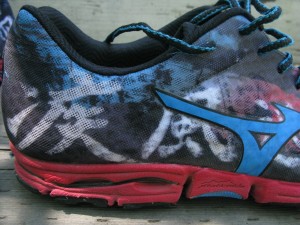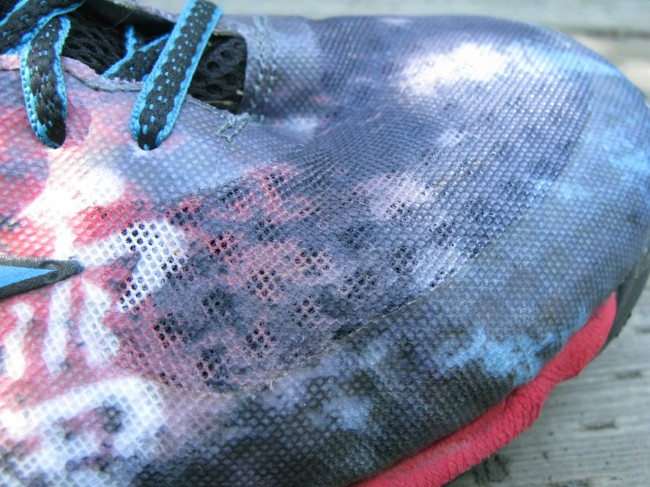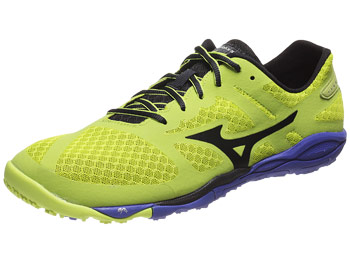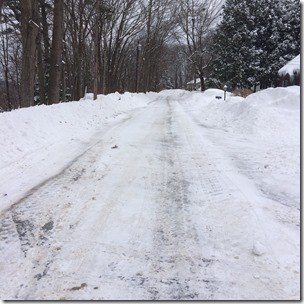Other than running in the Mizuno Wave Universe 3 a couple years ago, I have not run in any other Mizuno shoe. When Pete asked if I’d be interested in reviewing the Hayate, I was excited to try out, what was for me, an untested brand and one that was making an effort to release some revamped trail shoes in the form of the Wave Hayate and Wave Kazan.
I had heard that Mike Aish, a Mizuno-sponsored trail ultrarunner and former Olympic track athlete, was involved in helping Mizuno develop the Kazan (video from Mizuno on his involvement here; can’t help but notice Mikes great form and smooth forefoot/midfoot landing even in a 12mm drop shoe :) ). I have not seen any info regarding if he was involved in the Hayate, but given the similarity in design, I’m assuming the Hayate was influenced by the Kazan and was just stripped down somewhat to offer a lighter shoe. This approach might have been the Hayate’s undoing and I’d be curious, in this case, if the Kazan is not the better of the two shoes, despite my aversion to the higher (12mm) heel to toe differential. I’ll explain more below.
Shoe Specs
Price: $110 MSRP
Colorways: 1 color
Weight: 8.9 oz/252 g in size 9 mens; 11.1 oz/315 g in my size 13 men’s; and 7.4 oz/209 g in size 8 for women (stats via Running Warehouse)
Stack Height: 21 mm Heel; 15 mm Forefoot; Mizuno claims the midsole has a 9mm heel to toe differential, whereas the stack heights show only a 6mm differential – this is easily explained when looking at the shoe as the outsole forefoot lugs are easily 3mm higher than the heel lugs. In actual ride, the shoe feels closer to 8-9 mm drop to me.
Appearance & Design
 This is one area where Mizuno shines. Their shoes continually look very unique, bold, and, in my opinion, are some of the best looking shoes out there. The Hayate is a very eye-catching trail shoe, and does so while maintaining a clean and simple design as well.
This is one area where Mizuno shines. Their shoes continually look very unique, bold, and, in my opinion, are some of the best looking shoes out there. The Hayate is a very eye-catching trail shoe, and does so while maintaining a clean and simple design as well.
Something I do question from a design standpoint with a shoe like this for trails is the inclusion of Mizuno’s pervasive “wave” technology in the heel with nothing in the forefoot. I’m not entirely sure how the Wave plate works on road and less sure on trails. It doesn’t seem to move into the midfoot (like the shanks found in many racing shoes) at all either, which I think would help at least add some structure underfoot. As it is, I would not have known it was there if I didn’t see it plainly exposed on the side of the midsole. Can anyone out there share their experience with the wave technology? Have you experienced any benefit? Otherwise, the design seems to be a hybrid of a simply constructed trail shoe with a somewhat traditional marathon racing shoe in terms of geometry and stack height.
Materials & Construction
The Hayate seems to be constructed with quality materials throughout. The mesh upper is simple and durable (still looks brand new), the shoe is comfortable sock-less, and the outsole appears to be holding up very well after 50+ miles of use. I always wish that companies would not skimp on forefoot rubber and Mizuno does a decent job here. However, it is the thinnest of all the areas on the shoe (excluding the lugs) and they even have a few cutouts right in the forefoot (I presume for added flexibility) that make it feel even thinner in those spots.
I’m unfamiliar with Mizuno’s different types of midsole materials, but they use an eva compound called U4ic that is supposed to be 30% lighter than their more standard AP+ compound. This sounds very similar to New Balance’s ubiquitous RevLite midsole, and honestly, seems somewhat similar. Light and flexible, but not very dense and packs out somewhat quicker than traditional EVA.
Fit
The fit of the Hayate is fairly average in nearly every way. I find it average width, volume and security. It doesn’t stand out in any one way fit-wise, negative or positive. I’d like it to be more secure in the midfoot and heel, but it’s still just secure enough to be sufficient. The heel counter is one that I do notice on steep uphills (over 25% grade). I would guess part of that is the wider heel fit and part the height and stiffness of the counter. Overall the fit is not problematic, but could be improved with more security and a better heel fit.
Ride
Outsole. Good overall tread pattern and it is holding up well (again, black rubber is good!)
The Hayate rides quite nice…on smooth, hardpack trails, or even on pavement (but to a lesser degree). It runs actually quite similar to the North Face Ultra Trail that I reviewed back in May: nice on smooth trail and somewhat responsive for a trail shoe on roads. The Hayate does better than the Ultra Trail on more technical and windy single track, but still, like the NFUT, lacks the forefoot protection that I would expect from a shoe in the 9 oz range. If I am going to put up with the 9mm drop and heavier weight, I expect more rock protection than that of a 7 oz racing flat. I really don’t understand this trend. It seems like many manufactures are making these 9 oz shoes as their racing models and, therefore, they expect the consumer is not looking for protection, but rather a shoe that, while still having a somewhat traditional geometry, feels lower, lighter and more responsive. For me, coming at it from a minimalist perspective, the Hayate is heavy enough to be a long run shoe, but doesn’t offer the forefoot protection for rocky trails. This is somewhat frustrating as it is otherwise a good shoe. The lack of adequate rock protection probably prevents many from trying the shoe who otherwise might.
Overall Impressions
My quandary about the lack of forefoot protection leads back to the explanation of my title: A Decent, But Mis-matched Trail Shoe. The shoe seems to be mismatched from the forefoot to the heel. The forefoot feels low and responsive like a racing flat, but the heel feels like a pretty substantial, nearly traditional shoe (especially with the inclusion of the wave plate). Mizuno did well in not flaring the heel much, which helps the stability on more technical trail, but it still does not match the light and flexible forefoot. Either this shoe needs more forefoot protection to be able to be a responsive all-around trail shoe or needs to be lightened up a bit (i.e. drop heel stack and ditch the wave plate) to run more like a racing shoe. As it is, it just sits in a weird spot for me and doesn’t deliver what I’m looking for in a 9 oz trail shoe.
For many who are used to running in traditional shoes (with 12mm drop, like the Kazan for ex.) then the Hayate will likely fit the role as a more speedy option for short runs while not having to go too minimal with the heel to toe drop. For those used to a lower drop trail shoe (such as Nike Kiger/Wildhorse, Brooks PureGrit, or inov-8 Trailrocs for example) you’ll be scratching you head because all of those shoes offer more protection (and cushion in many cases) than the Hayate, and are typically as light or lighter.
Like I hinted at in the opening of the review, I think the Mizuno Wave Kazan might be the better of the two trail shoes from Mizuno. Even though the 12mm drop is less appealing to me, it’s likely a more complete shoe and would work better as a long run trail shoe than the Hayate. Unfortunately the Hayate straddles the fence too much between long run shoe and speedier racing shoe and doesn’t end up doing either well enough in today’s market to stand out.
Purchasing Options
The Mizuno Hayate is available for purchase at Running Warehouse, Zappos and Amazon. Outside the US it can be purchased from Wiggle. Purchases made via these links provide a small commission to Runblogger help to support the production of reviews like this one – thanks!























When it comes to making a trail shoe, Mizuno has a habit of taking one of their rode shoes, slapping some lugs on it, changing the color and calling it a trail shoe. The exception to this, in my experience is the Wave Evo Ferus (one of my favorite trail shoes). The impression one gets is that they want to offer a trail shoe without any effort in developing it for trail running.
This and the Kazan were built from the ground up to be trail specific. This midsole/outsole isn’t used in any road shoes.
I do think Mizuno tried on these two shoes and did indeed build them specific for their models (i.e. didn’t reuse any midsole molds from a road shoe), but the Hayate ended up not being much different in practice than many standard road/marathon shoes with a little trail tread. More trail specific would fix the issues, namely more trail specific fit and rock protection.
That’s funny, I emailed Mizuno awhile back suggesting they do just that (lightly convert a road shoe) The Kayate was my first Mizuno trail shoe I ever tried (enjoyed Mizuno road shoes in the past, really liking the Hitogami) but the Kayate did not work for me, after 5 miles my toes were getting killed just not the roomy toe box Mizuno usually offers, also within the first 5 miles I rolled an ankle three different times..I never roll ankles…only other time was in a Wave Precision I was using on technical single track runs (didnt blame the shoe since I was using it improperly lol) but the point is the high profile and big drop shoes can make you roll an ankle on a trail…I to me this is a very unstable shoe.
Anyway I did pick up a pair of the Kazan but just running around the house that clunky heel was making me crazy and I have not run in them yet, may not and just return them…that drop is huge…
Regarding your wave plate question, I try to ignore it, Being a fore foot and mid foot striker not sure it applies to me…I did notice it in the Wave Precision and the Wave Rider or maybe it was just the big drop in those shoes…not so much in the Hitogami…the Hitogami I can sometimes feel it walking but never when running..think you or someone mentions the Evo Cursoris I returned those the nest day after they arrived..I felt all kinds of stuff in the heel did not even want to run in them was very disappointed..I was expecting a zero drop shoe and did not feel like it at all
Many of us love the fore foot and ground feel/response of Mizuno’s..just the right amount of cush and response. The uppers are usually excellent and comfy as well, as a result we or I should say I tolerate the wave plate thingie …
Bill. Thanks for you comments. Agreed on many points and I’ve been toying with the idea of trying the Hitomgami (and just might after your comments). I personally think the instability of the Hayate can mostly be attributed to the wave plate and higher stack height of the heel. A stiff, higher, heel is nearly always more unstable than something lower and a bit more flexible.
FYI I have noticed the Hitogami is being discounted everywhere, found out version #2 is coming out in January but you can find some bargains now, good time to try it…
Have you tried the Pearl Izumi N1 Trail? ..that’s been the best so far for me out of all the trail shoes I tried recently (still searching for the magical perfect trail shoe) only reason I hesitate to recommend as I have had some inconsistent sizing issues with it from shoe to shoe/color to color, seen the same complaint from other reviewers…It also has some technology in it (E Motion) I try to ignore but the upper is fabulous and my legs feel good after running in them
I did notice the Hitogami and ordered a pair to try on from Running Warehouse (like $59). I have run in the PI N1 trail and road and while they do work ok for me, I’m not a big fan of the rockered design (E Motion) and chunky midfoot. I’ve run a trail 50k in them and they worked out ok (good uppers like you said), but not good on technical at all and just wasn’t digging the rocker induced roll in the ride. A similar shoe that I prefer over the PI’s is the inov-8 Race Ultra 290, much better outsole, better fit and ride without the rocker, and handles technical much better while still protecting for long stuff.
I agree with you on the Pearll Izumi Trail N1..first pair I got was good others after that not so much, amazing how a shoe can vary…did some quick research on the inov-8 Race Ultra 290 I may have to try that! thanks for the tip
Hayate, not Kayate. Are you talking about the same shoe?
I think it is just a typo…Mizuno hasn’t made a Kayate as far as I know :).
I had been wanting to try this shoe, but will stay with Salomon for trails for the time being. I enjoy my mizunos on the road, but totally get the point of trying to take road racing shoes and convert to trial shoes. Great review thanks
Thanks for the comment Gordon. Agreed on taking a road shoe and making it more suitable for trails. This often is a great idea as long as certain things are implemented (mainly I find a more secure fit, a little firmer ride, and rock protection to be the most helpful changes along with slightly lower stack heights if you want the shoe to run better on technical terrain).
You know one thing I should add, I am finding many minimal road shoes offer more rock protection on the trail than minimal trail shoes…For example on one of my favorite trails to run I do fine in the Hitogamis, I took my Altra Superior 1.5 out on that same trail and the gravel and rocks were killing me..you would never tell that comparing the shoes/soles..I was shocked
David, I think you have just tried a typicall Mizuno shoe: a thin and responsive forefoot with a more structured heel (the wave is responsible for this). For some of us, Mizuno rides very smooth and gentle. Personally I am a forefoot/midfoot striker and I love the feedback that the forefoot provides in almost any Mizuno`s shoe. As for the lack of rock protection, it made me avoid this shoe when I recently bought a pair of trail shoes (NB 1010v2). Maybe the shoe must be considered as one of those door to trail shoes, good in pavement, good for hardpack trails…but not the best choice for dificult ones. From this point of view the shoe might have more sense.
Fernando,
I agree fully with your assessment. The Hayate is actually somewhat decent as a door to trail shoe, but the is where it ends for me. With some design changes, I don’t think this has to be the case, but as it sounds from feedback from others like yourself, this is somewhat common for Mizuno (thin forefoot and more built up heel) and it may not be a liability on the roads, but doesn’t work as well on trails. Thanks for the input.